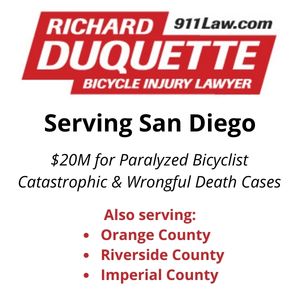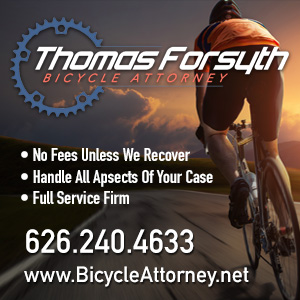“Get the fuck off the road!”
— Dr. Christopher Thompson to cyclist Patrick Early, as told by Asst. D.A. Mary Stone
After two weeks of testimony, it all came down to this.
Two talented attorneys facing off before the jury, summing up days of impassioned first-hand testimony, complicated technical evidence and the insights of expert witnesses — in some case, highly paid experts — to direct them to a single inescapable verdict.
Guilty.
Or not.
And now the Good Doctor’s freedom, and his career, hangs in the balance.
“This coat can inspire trust”
According to cyclist/attorney DJwheels, the biking community’s eyes and ears in the courtroom, Assistant District Attorney Mary Stone offered an effective closing argument delivered through a series of well-chosen props.
She began by donning a white medical coat, and asked the jurors if they remembered questioning during jury selection about what it means to be a doctor, and if doctors can commit crimes. She then offered a series photos of showing well known TV physicians wearing a similar coat.
“I don’t want you to get confused,” she said. “Because this coat can inspire trust.”
She showed a photo of the Grand Canyon, explaining that there is a big, wide line that you just don’t cross, because “there’s a canyon in between.”
“You don’t use your car to hurt people.”
That was followed by a recap of the testimony offered by Patrick Early, the first cyclist Dr. Christopher Thompson is accused of threatening with his car, though he was not charged with that encounter.
According to Stone, the doctor offered a long list of dates when the incident could not have happened because of work or travel. Yet he left a number of days unaccounted for — days when he could have yelled at Early to get off the road, then slammed on his brakes directly in front of the rider’s bike, just as he is charged with doing twice more in the following months.
She noted that Early worked in the auto industry and had an in-depth knowledge of cars, and so was able to identify the color, make and model of the vehicle that nearly ran him off the road, as well as recalling Thompson’s personalized license plates months later.
“The cry of an honest man”
She moved on then the next incident, which occurred the following March.
Cyclists Patrick Watson and Josh Crosby were riding down Mandeville Canyon, at or near the posted 30 mph speed limit, when Thompson again slammed on his brakes, forcing Watson off the road.
Stone told the jurors that Christopher Thompson chose to break the law. He was already speeding when he encountered the cyclists, she said, and he chose to engage the cyclists even though he had other options. He could have left; he could have kept going.
She noted the beginnings of a pattern. “We now know what enrages him.”
Stone went on to say that the defense will tell you that Watson had a grudge against Thompson, and that the angry emails Watson sent to friends and other cyclists after the incident show he wanted to get even with the doctor.
She played Watson’s 911 call for the jury, pointing out that Watson stayed at the scene waiting for the police for over an hour and a half after the incident, and gave his name and phone number to the operator. If he was a rogue cyclist, as Thompson claimed, why would he identify himself to the police, she asked?
And she described the emails as “the cry of an honest man.”
“Have a good laugh at that”
As for the incident with Ron Peterson and Christian Stoehr, she reminded the jurors once again that he could have kept going. If you slam on your brakes in front of two cyclists, she explained, you have to expect that they could hit you. “That’s just common sense.”
“He wants you to believe that he just wanted to take a picture,” she said. “That’s ridiculous. When you get back into the jury room, have a good laugh at that.”
At that, defense attorney Peter Swarth objected — one of three times he defied judicial courtesy by objecting during another attorney’s closing arguments; like the other two times, he was overruled by the judge.
She continued by saying that even if he did want to take a picture of the riders, as he claimed, it was his choice to stop in front of them. He was also “disdainful” of the injuries the riders suffered as a result.
“What if you went to the emergency room and your loved one was bleeding from the face, and the doctor told you it wasn’t serious?”
Because of what had happened to his childhood friend, Stone added — reminding the jurors of Thompson’s earlier testimony about a friend who fell from his bike and was run over by a car — he should have had a heightened sense of the fragility of cyclists.
“He knows what can happen.”
She added that the doctor can’t escape the fact that he was driving recklessly. And reminded them about the testimony of LAPD Officer Rodriguez, who said Thompson’s admission that he slammed on his brakes to teach the cyclists a lesson was “burned into his brain.” Who is more believable, she asked, an experienced LAPD officer or the doctor who had just injured two cyclists?
Thompson knew exactly what was going to happen, Stone said. She finished by showing photos of the injuries suffered by Peterson and Stone, ticking off a list of the charges, and asking the jury to find the doctor guilty on all counts.
“No crime occurred”
DJwheels didn’t consider defense attorney Peter Swarth’s closing argument nearly as engaging or effective as Stone’s.
Swarth began by projecting a single word — “Accident” — onto the screen, explaining that this may have been an unfortunate event, but, he insisted, it was not a crime.
“The prosecution says my client is full of rage, but there’s no evidence of that,” he said, adding that only Patrick Early claimed to see an enraged Thompson behind the wheel — and he only saw Thompson through the car’s rear view mirror.
And that event never happened, according to the defense; no charges were ever filed “because no crime occurred.” The other riders never saw the doctor’s face until he exited the car, thanks to the tinted windows on his Lexus.
He also claimed that Early’s identification of Thompson was tainted. According to Swarth, the LAPD detective investigating the case showed Early an old DMV photo of the Good Doctor, part of a photo lineup designed to get the result the police wanted.
Early’s credibility was also strained, Swarth said, since he couldn’t even remember if the incident occurred in December 2007 or January 2008. And while Early testified that he didn’t know any of the other riders who testified in this case, he had worked at the Ground Zero advertising agency in 2001, at the same time Christian Stoehr was there.
“Their actions belie their testimony”
Watson and Crosby weren’t credible, Swarth claimed, noting that they testified they had moved over once they became aware of the car behind them.
“Why would my client tell them to ride single file if they were already riding single file?”
“They say ‘This guy tried to kill me.’ But why would they stand in front of the car of someone who had just tried to kill them?” He added that it just didn’t make sense to ask someone to get out of his car if he had just tried to kill you. They were mad, he said. “Their actions belie their testimony.”
And he insisted that the speeds recorded by Watson’s Garmin proved that he never left the roadway and bunny hopped onto the grass as Watson and Crosby had testified.
According to DJwheels, however, that argument didn’t seem to make any sense.
“How can a horn be angry?
Swarth then moved on to the incident with Watson and Stoehr, asking where the evidence was that proved the intent necessary to support the criminal charges.
He reminded the jury they had testified that Thompson honked his horn in an angry and aggressive manner. “How can a horn be angry? It’s just not true.” He also noted the gruesome photos of their injuries, asking the jury not to convict his client based on those photos alone.
He then attempted to discredit various aspects of the rider’s testimony.
Swarth said that Stoehr had testified that when Thompson slammed on his brakes, he clipped the back wheel of Peterson’s bike, hit the back of the car, flipped over it and landed in the street in front of the vehicle. “That just did not happen,” he said.
According to Swarth, what really happed was that Stoehr looked back after passing the car, saw what had happened to Peterson, then lost his balance and simply fell over.
He said that Thompson told the riders to get their bikes out of the street because emergency vehicles were on their way. And he asked what kind of cycling coach — referring to Peterson — teaches his student to respond in an angry manner, reminding them that Peterson had said “I’m going to fuck you up” immediately following the collision.
If Thompson was so enraged, as the riders claimed, why did he call 911 to get them help? Maybe he just used the wrong words in claiming that the injuries weren’t serious, Swarth suggested. “He was just trying to get the right help to arrive.”
“How can 30 years of trying to help people just disappear in a moment?”
He displayed a photo showing Thompson’s Lexus next to the curb. “Doesn’t it look like he was just trying to park his car?”
Then he turned his attention to the third rider on the road that day, asking why Chris Parker wasn’t injured. The answer, he claimed, was that Parker was simply more careful.
He finished by asking about Officer Rodriguez’s testimony, in which he said the Good Doctor admitted he did it intentionally. Rodriguez never asked the follow-up question, Swarth claimed.
“What do you mean you wanted to teach them a lesson?”
He added that maybe someone else in the crowd had said that, and Rodriguez mistakenly attributed it to Thompson.
It was all a tragic accident, Swarth concluded.
“Sometimes the thing that you seek to avoid becomes the thing you can’t avoid.”
“This is exactly what happens”
Stone then followed up with a powerful rebuttal, holding a baseball bat in front of the jury.
Let’s say you go into a grocery store, she suggested, and someone is blocking the aisle you need. So you threaten them with the bat, and say “Get the fuck out of my way.”
Then the next time you go in, it happens again. But this time, the people blocking your way say “Fuck you.” So you swing your bat at them. You miss, but they get out of the way. Then it happens a third time — and this time, you connect with the bat.
“That’s what happened here,” she said.
She paused to put on the white doctor’s coat she’d worn earlier, suggesting that the Good Doctor had wrapped himself in that afterwards to deflect responsibility.
Then she concluded by picking up Peterson’s shattered bike and holding it in front of the jury. “This”, she said, “is exactly what happens when you slam on the brakes in front of someone.”
According to DJwheels, one of the doctor’s supporters could clearly be heard responding in the gallery.
“Bullshit.”
Jury deliberations resume this morning at 9:30 am. DJwheels says he doesn’t expect a verdict until sometime Tuesday, or late today at the earliest. I’ll post it on here as soon as I’m able to get it online. VeloNews has a well-written summary of closing arguments, and the L.A. Times offers an overview of the trial, saying cyclists have a lot riding on the case.
I’ll post my usual links to articles later this afternoon.
Like this:
Like Loading...






